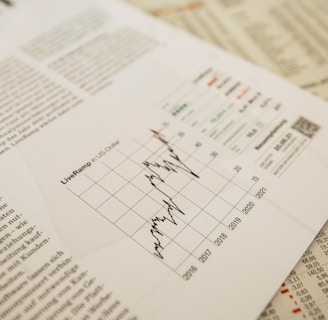The Blueprint for Your Portfolio: A Beginner’s Guide to Financial Resilience
Think of your portfolio as a fortress. Are the walls strong enough to weather any storm? Find out how to build a portfolio that stands the test of time.
BUILDING YOUR FOUNDATION
8/18/20254 min read


Picture this: you’re standing in front of a castle. Its walls are high, its gates sturdy, and inside, everything you value is protected. That’s exactly how your investment portfolio should function—a fortress strong enough to withstand financial storms, from market crashes to inflation spikes.
But here’s the question worth asking: is your portfolio built like a fortress… or a sandcastle?
In this beginner-friendly guide, we’ll lay out the blueprint for a resilient financial portfolio that doesn’t crumble the second the tide comes in.
Why Financial Resilience Matters
Let’s be real: markets are unpredictable. One week, stocks are soaring; the next, headlines scream about recessions, interest rates, or global crises. You can’t control the markets—but you can control how well-prepared your portfolio is.
Financial resilience means this: your investments keep you standing tall even when the markets wobble. Think of it as shock absorbers for your wealth. Legendary investor Warren Buffett once said, “You only find out who is swimming naked when the tide goes out.” The tides will go out—it’s just a matter of when. Your job is to make sure you’ve got your swimsuit on.
Blueprint Step 1: Diversify Like a Fortress
Here’s Investment 101, simplified: don’t put all your eggs in one basket.
Imagine building a fortress with walls only on one side. It might look strong from a distance, but one weak point leaves you exposed. Same with your portfolio—if you bet everything on just one stock or sector, it’s like leaving the back door wide open.
Diversification spreads your investments across different asset classes (stocks, bonds, real estate, maybe even a pinch of cash or commodities). Why? Because different assets react differently to the same storm.
Stocks can power long-term growth.
Bonds act as stabilizers during downturns.
Cash keeps you liquid when opportunity knocks.
Real estate or ETFs can add an extra layer of balance.
Tweetable insight: A fortress portfolio isn’t about predicting storms—it’s about surviving them.
Blueprint Step 2: Know Your Risk Tolerance
Financial resilience isn’t one-size-fits-all. Your fortress design depends on the kind of warrior you are.
Ask yourself:
If my stocks dropped 20% tomorrow, would I panic-sell or calmly ride it out?
Do I need my invested money soon, or can I leave it alone for years?
Am I more focused on growth (adding towers) or protection (reinforcing walls)?
Risk tolerance is simply your comfort zone in investing. Younger investors can usually afford to take on more risk because they have decades to bounce back. Older investors, closer to retirement, often prioritize stability.
Pro tip: If you can’t sleep at night because of your investments, your fortress is built wrong.
Blueprint Step 3: Build in Layers (Asset Allocation)
Every fortress worth its salt has multiple defenses: outer walls, inner gates, and maybe a moat with alligators. Your portfolio needs layers too.
Enter asset allocation—the strategic mix of assets you hold. This isn’t just diversification (spreading your eggs around); it’s about the right proportions of each basket.
For beginners:
70/20/10 rule of thumb → 70% stocks, 20% bonds, 10% cash/emerging assets.
Young and fearless? Tilt heavier toward stocks.
Cautious or nearing retirement? Increase bonds and cash.
Asset allocation is like architecture—get the structure right, and the fortress can withstand just about anything.
Blueprint Step 4: Expect the Unexpected
Markets will surprise you. Remember 2020? Entire economies hit pause, yet stocks rebounded faster than anyone predicted. The point is: if you only plan for smooth sailing, you’ll capsize during the first storm.
How to future-proof your portfolio:
Emergency Fund: 3–6 months’ living expenses in cash.
Regular Rebalancing: Once a year, reset to your target allocation. (If stocks boom, trim them back; if bonds dip, add more.)
Global Perspective: Don’t ignore international markets—they give your fortress extra escape routes.
As John Bogle, founder of Vanguard, advised: “Investing is an act of faith in the future of companies and the economy.” Faith is good, but preparation is better.
Blueprint Step 5: Keep Emotions Out of the Equation
The fastest way to tear down your financial fortress? Let panic drive your decisions.
History shows that investors who sell during crashes often miss the rebound—the very moment wealth is built. In fact, J.P. Morgan Asset Management found that missing just the 10 best stock market days over 20 years can cut your total return in half.
That’s not a typo. Half.
So, when fear and greed come knocking, remember: the strongest fortress walls are patience and discipline.
Future-Proofing Your Life, Not Just Your Money
Here’s the real secret: building financial resilience isn’t about getting rich quick. It’s about creating a future where you sleep peacefully knowing your money is working harder than you are. It means freedom to take risks in life without fearing every market headline.
Whether you’re a complete beginner or just looking to strengthen your foundation, the blueprint is clear:
Diversify.
Know your risk tolerance.
Allocate in layers.
Expect surprises.
Master your emotions.
Final Word
Your portfolio is more than numbers on a screen—it’s your financial fortress. Build it with care, maintain it with discipline, and it will protect you from the storms ahead.
So, ask yourself: Are your walls strong enough?
If you’re ready to stop guessing and start building with confidence, Savvport is here to hand you the blueprint, the bricks, and the mortar. Let’s build your fortress together.
